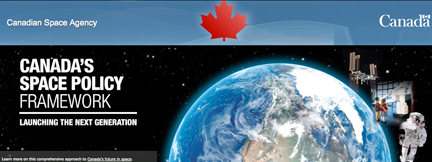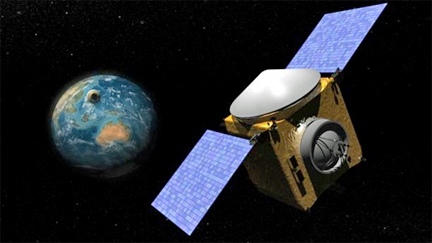
[SatNews] In partnership with MacDonald, Dettwiler and Associates Ltd. (MDA) and the National Aeronautics and Space Administration (NASA), the Canadian Space Agency (CSA) is advancing Canada’s leadership in the niche technologies of Light Detection and Ranging systems (Lidar) through Canada’s first international mission to return a sample from an asteroid to Earth.

Artistic rendition of the OSIRIS-REx satellite.
Image courtesy of Lockheed Martin.
The US‑led Origins-Spectral Interpretation-Resource Identification-Security-Regolith Explorer (OSIRIS-REx) mission will study Bennu, an asteroid that has the potential to impact the Earth in the late 2100s. Canada’s contribution to the mission is the OSIRIS-REx Laser Altimeter (OLA), a sophisticated laser-based mapping system to be manufactured, assembled and tested by MDA and Optech. OLA will be used to create unprecedented 3D maps of Bennu to help the mission team select a site from which to collect a sample. In exchange for OLA, the CSA will own four percent of the total returned sample, providing the Canadian scientific community with its first-ever direct access to a returned asteroid sample as well as strengthening the CSA's international partnership with NASA.
- The Canadian Space Agency has awarded a contract worth $8.84 million to MacDonald, Dettwiler and Associates Ltd. to begin building the OSIRIS-REx Laser Altimeter.
- The Canadian Space Agency will deliver the OSIRIS-REx Laser Altimeter to NASA by November 2015 for integration onto the spacecraft. OSIRIS-REx will launch in September 2016 and will reach Bennu in late 2018. The sample will return to Earth in 2023.
- The Canadian science team is headed by Dr. Alan Hildebrand of the University of Calgary; Dr. Michael Daly of York University is the deputy principal investigator and the OSIRIS-REx Laser Altimeter instrument scientist. The team also includes researchers from the University of Winnipeg, the University of Toronto and the University of British Columbia.
- Bennu was named by Michael Puzio, a third-grader from North Carolina who entered a “Name that Asteroid!” contest organized by the mission.
- The name refers to the Egyptian mythological bird Bennu, which Puzio thought the spacecraft, OSIRIS-REx, resembled.
- People around the world are invited to send their names on a round-trip ride to asteroid Bennu. All names will be etched on a microchip aboard the spacecraft that will travel to Bennu, spend about 1000 days in the proximity of the asteroid, and journey back to Earth on the sample-return capsule. The sign-up campaign is open until September 30, 2014.
- The Canadian Space Agency’s total investment in OSIRIS-REx for the full life cycle of the mission is $61 million over 15 years to support the development of OLA and the science team. This includes the $8.84 million contract with MacDonald, Dettwiler and Associates Ltd. to build the OSIRIS-REx Laser Altimeter.
The Canadian Space Agency's infosite may accessed via http://www.asc-csa.gc.ca/

